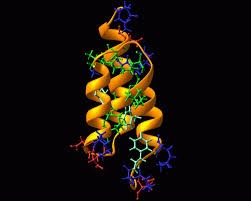So, last week we discussed Amino Acids… now, let’s be blunt, let’s be quick, let’s talk PROTEINS.
Protein Structure: There are four levels of protein structures and those are as follows
v Primary
v Secondary
v Tertiary
v Quaternary
But, what determines these levels of protein structure?
Who says polypeptide chains? Who says the linear sequence of amino acids? Who says both? Well I obviously don’t know who said what, but if you said both, you’re right!
Now let’s talk about how the levels are determined…
RECAP!!
As blogged before, the bond between two amino acids is called a peptide bond.
Peptide bonds are formed removing a water molecule from two different amino acids. The sequence of amino acids determines the positioning of the different R groups and this positioning determines the order in which the proteins fold and essentially the structure of the molecule.
PRIMARY STRUCTURE:
The linear sequence of amino acids that make up the polypeptide chain is determined by the genetic encoding of the sequence of nucleotide bases in the DNA.
SECONDARY STRUCTURE:
This is the regular folding of regions of the polypeptide chain. Two of the most common types of ‘protein folds’ are called the α – helix (coiled) and the β pleated sheet; which is folded.
|
The Hydrogen bonding in the secondary structure occurs between atoms in the peptide bond
TERTIARY STRUCTURE:
Tertiary… this is a three dimensional structure and is formed by the twisting of the polypeptide chain. The linear sequence of amino acids is usually folded into a compact structure and becomes stable by many non-covalent interactions between the side groups of the amino acids.
QUARTERNARY STRUCTURE:
Not many proteins reach to this stage of folding (protein structure) but one example of a protein that has the structure is Haemoglobin. This structure is formed by the combination of more than one polypeptide chain. Interactions between them are; ionic, disulphide, hydrogen bonds and hydrophobic (not afraid of water, but rather ‘water hating’) interactions.
RANDOM FACTS ABOUT PROTEINS.
- About 18-20% of the body’s weight is protein.
- Hair is made up of a protein called keratin, which forms a helical shape. It contains sulphur bonds and so the more sulphur links present, the curlier a person’s hair can be. (I LOVE CURLS)
- Protein is a macronutrient; these provide calories/energy and are essential for survival.
- The lifespan of most proteins lasts two days or less.
- Without Albumin, the human body would begin to swell. (When I think of Albumin, I think of eggs.. when I think of eggs, I think of PROTEIN)
- Protein in semen acts on the female brain to prompt the ovulation process. #fertilize #dontgetideas #okaygetideas
- Errors in protein function can cause diseases such as Alzheimer’s and cancer.
- The body needs protein to grow, heal, and carry about nearly every chemical reaction in the body.
- Complete or Whole Proteins contain all nine of the essential amino acids.
- Insufficient protein in diets can prohibit weight loss.
References:
Pictures
http://www.vitalityfitnesscalgary.com/protein-4-reasons/
http://www.slapcaption.com/josh-nichols-weight-loss-success/
http://hanguyenbiologyhlblog.blogspot.com/2013/01/proteins-homework.html
Information
http://www.bodybuildingpro.com/proteinrating.html
http://www.nature.com/horizon/proteinfolding/background/disease.html
http://www.youtube.com/watch?v=ZWLNkEJloJA&feature=youtu.be



